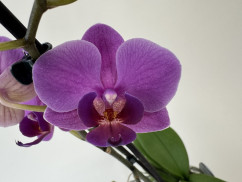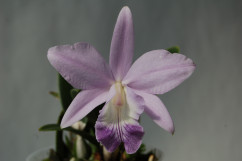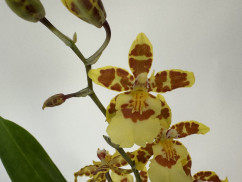Ascocenda

Ascocenda is closely related to Vanda and is therefore cultivated just as well. This applies especially for the home care of Ascocenda.
Ascocenda grows like Vanda with distinct aerial roots, which can soak up moisture like a sponge. Ascocenda, with good care, can bloom even easier than Vanda several times a year. They are usually slightly smaller-flowered than Vanda, but have more flowers on a stem.
Special orchid care instructions for Ascocenda (Ascda)
Especially the Ascocenda is qualified for a culture in glass vases. The care is much easier than cultivating them hanging. The glass needs to be flooded only 2 times a week to the lowest leaf rim. Only the roots have to be moistened. The water stays in the glass for half an hour and is then poured off again. Once a month add special Vanda Tillandsia fertilizer to the water. The size of the glass jar is always selected according to the root mass. The glass can be cleaned 1-2 times a year.

Arachnis Maggie Oei 'variegata'
- flower season: summer - autumn
- temperature: warm (20 - 24 °C
- Mehr Details

Ascocenda (orange) in der Glasvase
- flower season: whole year
- temperature: warm (20 - 24 °C
- Mehr Details
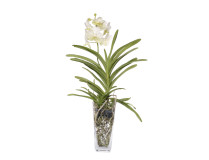
Ascocenda (weiss) in der Glasvase
- flower season: whole year
- temperature: warm (20 - 24 °C
- Mehr Details

Ascocenda Bavaria Blue x Holcoglossum wangii
- flower season: summer - autumn
- temperature: warm (20 - 24 °C
- Mehr Details

Ascocenda Blue Saphire (in Blüte/Knospe)
- flower season: whole year
- temperature: warm (20 - 24 °C
- Mehr Details

Ascocenda Hybride
- flower season: whole year
- temperature: warm (20 - 24 °C
- Mehr Details
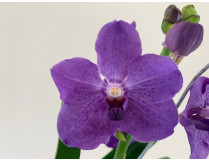
Ascocenda Just Blue (in Blüte / Knospe)
- flower season: whole year
- temperature: warm (20 - 24 °C
- Mehr Details

Ascocenda Magic Orange (in Knospe / Blüte)
- flower season: whole year
- temperature: warm (20 - 24 °C
- Mehr Details

Ascocenda Princess Mikasa 'Blue' (in Blüte / Knospe)
- flower season: whole year
- temperature: warm (20 - 24 °C
- Mehr Details

Ascocenda Princess Mikasa 'Pink' (in Blüte / Knospe)
- flower season: summer - autumn
- temperature: warm (20 - 24 °C
- Mehr Details

Ascocenda Princess Mikasa 'White' (in Blüte / Knospe)
- flower season: whole year
- temperature: warm (20 - 24 °C
- Mehr Details

Ascocentrum ampullaceum (Importpflanze)
- flower season: spring - summer
- temperature: warm (20 - 24 °C
- Mehr Details
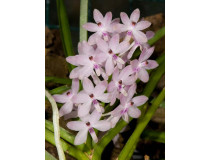
Ascocentrum christensonianum
- flower season: spring - summer
- temperature: warm (20 - 24 °C
- Mehr Details

Ascocentrum miniatum
- flower season: winter - spring
- temperature: warm (20 - 24 °C
- Mehr Details
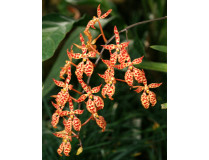
Renanthera monachica
- flower season: winter - spring
- temperature: warm (20 - 24 °C
- Mehr Details

Rhynchostylis gigantea 'Red'
- flower season: autumn winter
- temperature: warm (20 - 24 °C
- Mehr Details

Rhynchostylis gigantea 'spots' (in Knospe / Blüte)
- flower season: autumn winter
- temperature: warm (20 - 24 °C
- Mehr Details
Vanda & Ascocenda care
This flower is so popular in Singapore that it was chosen as the national flower: the vanda. It has similarities with the Ascocenda, to which it is closely related. This is immediately recognisable, as these two species have a similar appearance, a magnificent flowering spike and lush roots. Care is also very similar.
Aerial roots
Vanda and Ascocenda have pronounced aerial roots that store large amounts of water. In contrast to other orchid species, these two genera must therefore be cultivated entirely without substrate. They are therefore usually seen as hanging plants, but they also look good in glass vases or wooden baskets. If you decide in favour of a container - without a substrate - you should choose the exact size according to the volume of the aerial roots and clean it once or twice a year. The advantage: the plants are very easy to water. Fill the container with water until all the roots are submerged without wetting the leaves. The orchid now needs about half an hour to replenish its water reserves. Then pour out the remaining water completely and make sure that no residual water remains in the leaf axils, as this will quickly lead to rotting. As there is no moist substrate surrounding the roots, Vanda and Ascocenda need to be watered more frequently than other orchid representatives. Dip them twice a week or spray the aerial roots daily. During the flowering period from March to November, they appreciate fertiliser in the water once a month. Only use special Vanda tillandsia fertiliser, as it meets the requirements of both species perfectly.
Vanda & Ascocenda warm temperatures
Vanda and Ascocenda like it warm and humid, temperatures between 20 and 24 degrees Celsius and a relative humidity of 60 to 85 per cent are ideal. They also need plenty of light, but prefer a semi-shaded spot because they quickly get sunburnt. A north-west facing window is the best place for them. If it is too dark, your Vanda will thrive, but flower formation will be inhibited. In summer, when temperatures no longer fall below 15 degrees Celsius, they also feel at home in the garden. However, they need a semi-shady spot and an acclimatisation phase during which they can get used to the changed conditions.
Flowering times
From March to November, Vanda and Ascocenda delight us with their beautiful flowers up to three times. Once the flower stalk has faded and dried out, it can be safely cut off. They do not need a dormant period to produce flowers, but they do need good growing conditions: A bright location with warm temperatures and a sufficient supply of water and nutrients guarantees lush blooms.

 ... to newsletter subscription
... to newsletter subscription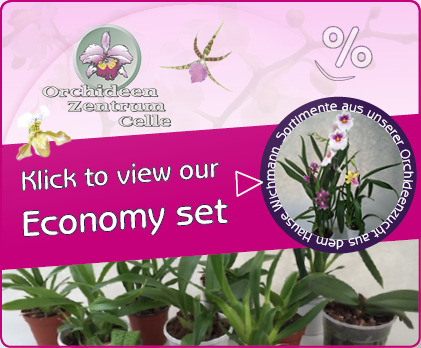 ... to see all economy sets
... to see all economy sets










